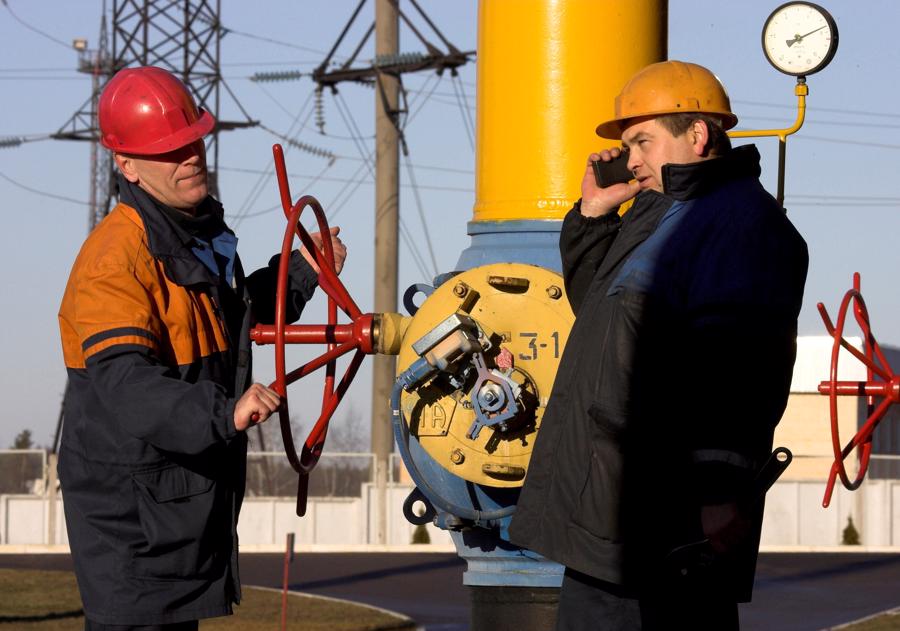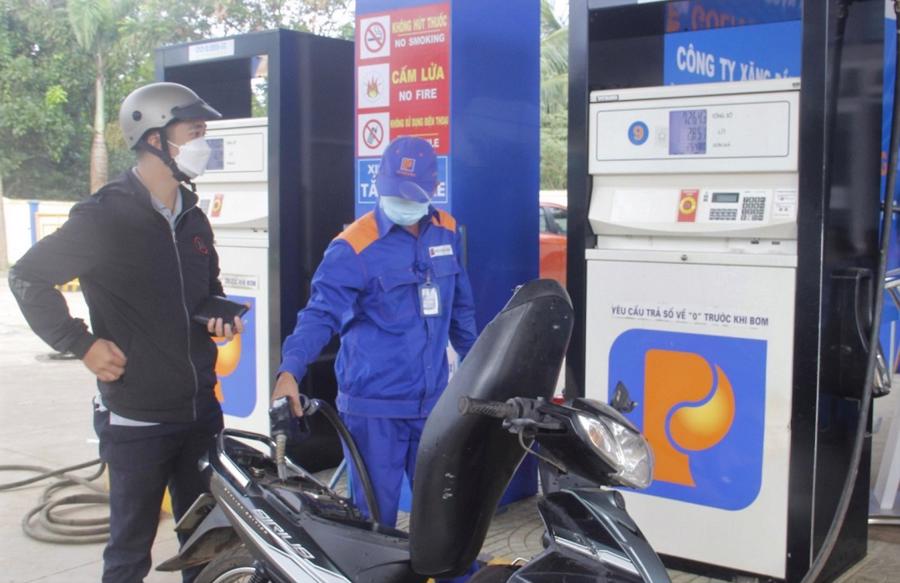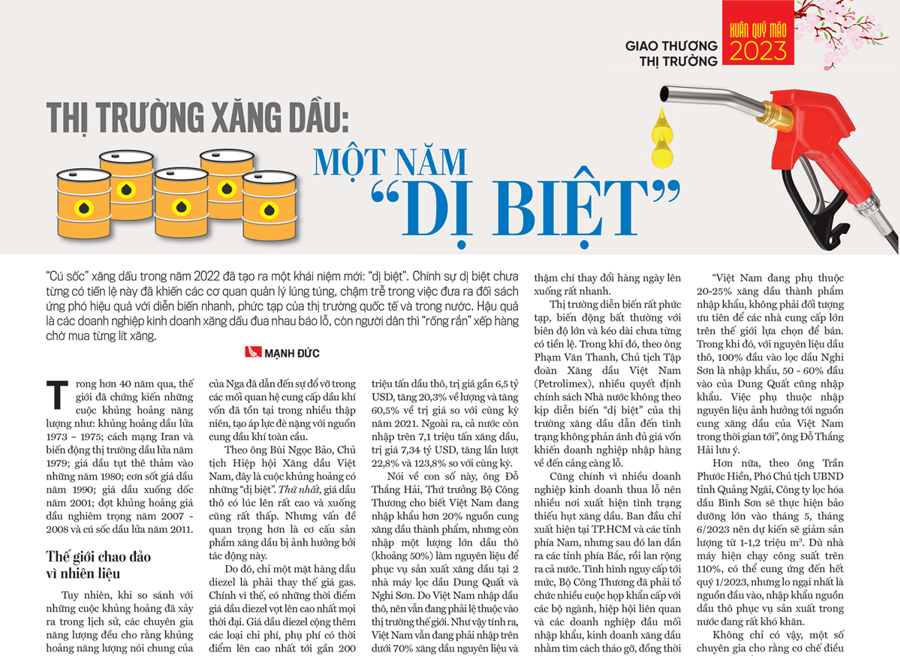[ad_1]
In the past 40 years, the world has witnessed energy crises such as the 1973-1975 oil crisis; the Iranian revolution and oil market turmoil of 1979; Oil prices plummeted in the 1980s; the 1990 oil price boom; the price of oil fell in 2001; the severe oil price crisis of 2007-2008 and the 2011 oil shock.
THE WORLD SHOULD BECAUSE OF FUEL
However, compared to the crises that have occurred in history, all energy experts say that the energy crisis in general in 2022 and the oil crisis in particular are very different due to many factors, especially political factors, plus the fact that two years after the Covid-19 epidemic, the post-epidemic decline in the global economy was accompanied by a structural recovery.
Especially in this crisis there is a shift in the energy structure. It is a gas that mainly supplies power plants in European countries, but due to the impact of the conflict between Russia and Ukraine since early 2022, it has directly affected this energy structure and affected the economy.

Although the global energy crisis is not necessarily caused by the Russia-Ukraine conflict, it makes the situation worse. The hostilities, Western sanctions and Russian retaliation have resulted in the collapse of decades-old oil supply ties and have put pressure on oil supplies.
According to Mr. Bui Ngoc Bao, chairman of the Vietnam Petroleum Association, this is a crisis with “differences”. First, the price of crude oil sometimes goes very high and sometimes falls very low. But the more important question is the composition of the petroleum products affected by these impacts.
Therefore, only a piece of diesel oil needs to replace the price of gasoline. Therefore, there are times when the price of diesel shoots up to an all-time high. The price of diesel plus all costs and surcharges reached a high of almost USD 200/barrel in some cases. Second, the degree of increase, the frequency of increase and decrease is extremely large. In particular, the price of oil can fluctuate around $10-12 per session in a day. In the past this cycle lasted 15-20 days even 1 month.
VIETNAM IS NO EXCEPTION
Not outside of the maelstrom, Vietnam is also badly affected by the crisis. Although the domestic supply of gasoline and oil is guaranteed for almost 80% of consumption demand, only 20% is imported, but in fact, the level of foreign exchange spending on the import of finished petroleum products and crude oil to serve the refineries of petroleum products and petroleum products Annual oil production is still very large.
According to the General Statistics Office, Vietnam imported nearly 10 million tons of crude oil worth nearly $6.5 billion in the 10 months of 2022, an increase of 20.3% in volume and 60.5% in value over the same period in 2021 corresponds. In addition, the whole country imported over 7.1 million tons of petroleum valued at US$7.34 billion, up 22.8% and 123.8% respectively over the same period.

Speaking about this number, Deputy Minister of Industry and Trade Mr. Do Thang Hai said that Vietnam imports more than 20% of the supply of finished petroleum products, but also imports a large amount of crude oil (about 50%) raw materials for fuel production, used for oil production in the Dung Quat and Nghi Son oil refineries. Since Vietnam imports crude oil, it remains dependent on the world market. Vietnam still has to import about 70% of raw materials and finished products.
In favorable market conditions, it is normal that large quantities of crude oil have to be imported to supply domestic refineries, even when this is economically advantageous. But in the context of the current supply crisis, escalating world oil prices and instability, refiners not only have to want to import, so the risk is also greater.
In fact, the domestic petroleum industry has faced many difficulties since the first months of 2022. In particular, immediately after the outbreak of the Russia-Ukraine conflict, petrol prices rose rapidly. Only from February to June, gasoline prices increased by about 60% – 70% compared to the previous one. From July, the price of gasoline fell by 20% and then rose by 7% to 8%, showing the rapid fluctuations of the market, which even went up and down very quickly on a daily basis.
The movements of the market were very complicated, unusually volatile with great amplitude and unprecedented length. According to Mr. Pham Van Thanh, Chairman of the Vietnam National Petroleum Group (Petrolimex), many policy decisions of the state do not keep up with the “other” developments of the petroleum market, resulting in a situation that does not correspond to the • enough cost of goods, to make even more losses for companies importing goods into the port.
This is also due to the fact that many companies are making losses, so that petrol is becoming scarce in many places. First appeared only in Ho Chi Minh City and the southern provinces, but then gradually spread to the northern provinces and then to the whole country.
The situation is so critical that the Ministry of Industry and Trade has had to hold many urgent meetings with relevant ministries, associations and major petroleum importers and traders to find ways to remove while deciding on solutions for petrochemical plants to increase their capacity maximize in order to ensure the supply of oil to the market.
The Treasury has also proposed and the Standing Committee of the National Assembly has agreed to cut the environmental tax on gasoline up to twice (April 2022 and early July 2022). In addition, the Ministry of Finance has adjusted the cost of transporting petroleum from abroad to Vietnamese ports by 60-660 VND/liter/kg (depending on the item) to eliminate difficulties for petroleum companies. By November 11, 2022, after an urgent meeting of the heads of government with ministries, branches and companies on oil management, the situation of the gasoline and oil supply has stabilized again.
2023: STILL SEARCHING FOR GASOLINE AND OIL
The gasoline “heat” has subsided, but the concern is still there. At the conference on preparing for Tet and stabilizing the market at the end of 2022 and Lunar New Year of the Rabbit 2023, Mr. Do Thang Hai informed that from December 5, 2022, EU countries introduced a maximum price for gasoline. from Russia. This could result in Russia finding other sources of customers and the EU looking for other sources, which could lead to unpredictable fluctuations in the oil market. At current consumption, Vietnam is not a priority destination for oil imports.
“Vietnam is 20-25% dependent on imported finished petroleum products, which is not a priority for sale for major suppliers in the world. Meanwhile, in crude oil, 100% of Nghi Son refinery’s input is imported, and 50-60% of dung quat’s input is also imported. Dependence on imported raw materials will affect Vietnam’s oil supply in the near future,” noted Mr. Do Thang Hai.
According to Mr. Tran Phuoc Hien, Vice Chairman of Quang Ngai Provincial People’s Committee, Binh Son Refinery and Petrochemical Company will carry out major maintenance works in May and June 2023, so production is expected to be reduced from 1 to 1.2 million m3. Although the plant is currently operating at over 110% capacity, it can deliver by the end of Q1 2023, but the main concern is the input source, importing crude oil for domestic production is very difficult.
In addition, some experts consider that the operation and price stabilization mechanism implemented under Decree No. 95/2021/CP is still insufficient, while compliance with reality for operation ensures the principle of sufficient calculation, the correct calculation was not active and the schedule is not flexible, especially the inter-ministerial coordination.
At the 2023 Minimum Total Petroleum Resource Allocation Plan meeting, the Ministry of Industry and Trade proposed two scenarios for the 2023 Minimum Total Petroleum Resource Allocation; scenario 1; Growth rate of 10% compared to 2022, equivalent to 25 million 900,000 m3; scenario 2; 15% growth, which corresponds to 26 million 760,000 m3. This issue is distributed monthly and quarterly. From January 1, 2023, corresponding adjustments will apply for each month and each quarter, based on the data carried out in the management software.
“In this allocation plan, the ministry asks companies to separate the relative amount of imported production and the purchase of domestically made goods. If companies do not have sufficient capacity, they join forces to import. Each company must have an import volume to confirm that the market is supplied in all situations,” the minister stressed, saying that the Ministry of Industry and Trade has submitted a proposal to the Prime Minister to draw up a decree amending the regulation. Amending and supplementing Government Decree No. 95/2021/CP and Decree 83/2014/CP on trade in petroleum and oil according to abbreviated regulation and procedures.
The content of the article was published in the special issue Xuan Quy Mao of Vietnam Economic Magazine, published on January 23, 2023. Welcome readers to read This:
https://postenp.phaha.vn/chi-tiet-toa-soan/tap-chi-king-te-viet-nam

[ad_2]
Source link

